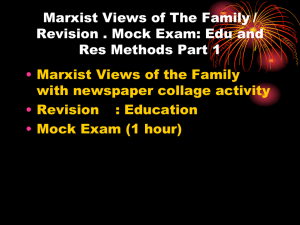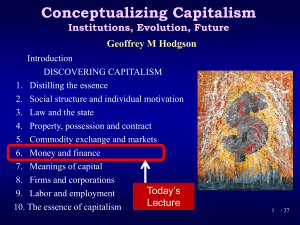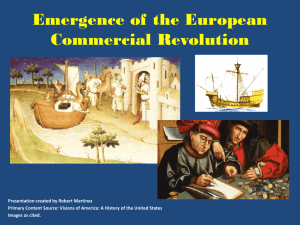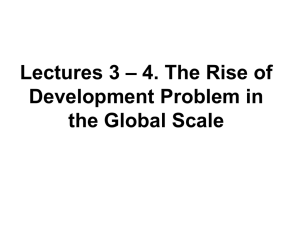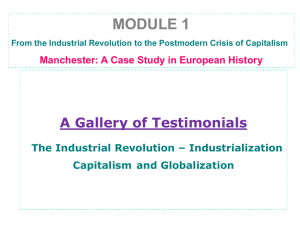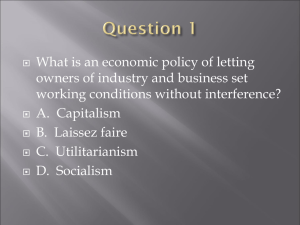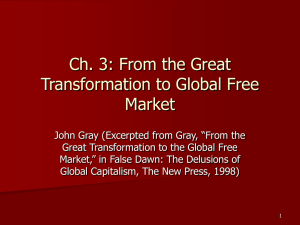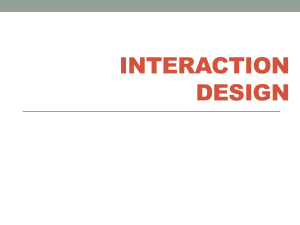Conceptualizing Capitalism
advertisement
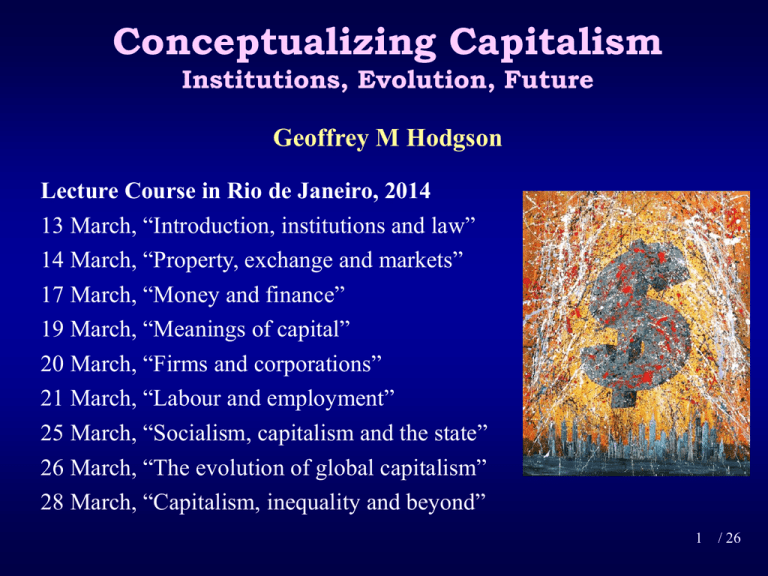
Conceptualizing Capitalism Institutions, Evolution, Future Geoffrey M Hodgson Lecture Course in Rio de Janeiro, 2014 13 March, “Introduction, institutions and law” 14 March, “Property, exchange and markets” 17 March, “Money and finance” 19 March, “Meanings of capital” 20 March, “Firms and corporations” 21 March, “Labour and employment” 25 March, “Socialism, capitalism and the state” 26 March, “The evolution of global capitalism” 28 March, “Capitalism, inequality and beyond” 1 / 26 Conceptualizing Capitalism Institutions, Evolution, Future Geoffrey M Hodgson Introduction DISCOVERING CAPITALISM 1. Distilling the essence 2. Social structure and individual motivation 3. Law and the state 4. Property, possession and contract 5. Commodity exchange and markets 6. Money and finance Today’s 7. Meanings of capital Lecture 8. Firms and corporations 9. Labor and employment 10. The essence of capitalism 2 / 26 Conceptualizing Capitalism Institutions, Evolution, Future Geoffrey M Hodgson 11. 12. 13. 14. 15. 16. 17. ASSESSING CAPITALISM Conceptualizing production Socialism, capitalism, and the state How does capitalism evolve? The future of global capitalism Addressing inequality Capitalism and beyond Coda on legal institutionalism 3 / 26 Conceptualizing Capitalism Lecture 1: Introduction, Institutions, & Law The aim is to understand the nature of capitalism. In 2012 capitalism and socialism were the two most consulted entries in Merriam-Webster Online Dictionary. My position is different from both Marxism and (promarket) libertarianism. Degradation by economists and sociologists of terms like “property”, “exchange”, “market”, and “capital”. 4 / 26 Conceptualizing Capitalism Lecture 1: Introduction, Institutions, & Law 5 / 26 Conceptualizing Capitalism Lecture 1: Introduction, Institutions, & Law Some features of the book: Emphasis on the role of the state and law, as well as on markets. Emphasis on the nature of property and its potential collateralization. Emphasis on inevitably incomplete markets within capitalism. Differential collateralizibility and sources of inequality. Discussion of non-socialist (in the classical sense), postcapitalist possibilities. 6 / 26 Conceptualizing Capitalism 30000 25000 20000 15000 Italy Netherlands 10000 UK USA 5000 0 1300 1400 1500 1600 1700 1800 1900 2000 GDP per Capita in Pioneering Capitalist Countries From Maddison (2007, p. 382). GDP (PPP) per capita in 1990 international dollars. 7 / 26 Conceptualizing Capitalism Lecture 1: Introduction, Institutions, & Law Western European GDP per capita was about 20 times larger in 2003 than it was in 1700. World GDP per capita in 2003 was about 11 times larger than it was in 1700. US GDP per capita in 2003 was about 12 times larger than it was in 1870. 8 / 26 Conceptualizing Capitalism Lecture 1: Introduction, Institutions, & Law But global growth since 1700 has seen a widening gap between rich and poor nations (Milanovic 2011). But between 1800 and 2000 life expectancy at birth rose from a global average of about 30 years, to 67 years … … and to more than 75 years in several developed countries (Riley 2001, Fogel 2004, Deaton 2013). 9 / 26 Conceptualizing Capitalism Lecture 1: Introduction, Institutions, & Law Does technology explain the post-1700 take off? What are the necessary conditions for the development and diffusion of new technology? Necessary communities of scientists and engineers, to scrutinize, share, and develop ideas. Necessary political conditions, financial system, property rights, patent laws, etc.. 10 / 26 Conceptualizing Capitalism Lecture 1: Introduction, Institutions, & Law A social structure is a set of social relations between interacting individuals. There are no successful micro-explanations of social phenomena in terms of individuals alone, without also taking into account relations between them. A social position is a designated social role within a social structure. Institutions are integrated systems of rules that structure social interactions. 11 / 26 Conceptualizing Capitalism Lecture 1: Introduction, Institutions, & Law A rule is a mutually understood injunction or disposition, that in circumstances X do Y. “Do Y” must be interpreted broadly, to include prohibitions as well as obligations. An organization as a special type of institution involving: (a) criteria to establish its boundaries and to distinguish its members from its non-members, (b) principles of sovereignty concerning who is in charge, and (c) a structure delineating responsibilities within the organization. 12 / 26 Conceptualizing Capitalism Lecture 1: Introduction, Institutions, & Law Is capitalism an ideology? Oregon Tea Party (2011): “capitalism is an ideology” that is responsible for economic success and individual freedom. Occupy Wall Street (2011): “Capitalism is an ideology that has gotten out of hand”. All social systems rely on ideologies and ideas. But ideas or ideologies are rarely accurate or adequate pictures of the system itself. How many people understand … money? … contracts? … 13 / 26 Conceptualizing Capitalism Lecture 1: Introduction, Institutions, & Law Base and superstructure? Marx Preface (1859): “The totality of these relations of production constitutes the economic structure of society, the real foundation, on which arises a legal and political superstructure and to which correspond definite forms of social consciousness.” Marx Capital(1867): “The juridical relation, whose form is the contract, whether as part of a developed legal system or not, is a relation between two wills which mirrors the economic relation. The content of this juridical relation (or relation of two wills) is itself determined by the economic relation.” 14 / 26 Conceptualizing Capitalism Lecture 1: Introduction, Institutions, & Law Base and superstructure? Marx failed to define key terms such as “economic structure,” “relations of production,” “economic conditions of production,” or “economic relations.” Marx and Engels, The Communist Manifesto (1848) : “The history of all hitherto existing society is the history of class struggles.” In 1888 Engels added a definition: “By bourgeoisie is meant the class of modern capitalists, owners of the means of social production and employers of wage labour. By proletariat, the class of modern wage labourers who, having no means of production of their own, are reduced to selling their labour power in order to live.” 15 / 26 Conceptualizing Capitalism Lecture 1: Introduction, Institutions, & Law Base and superstructure? In the third volume of Capital, in its unfinished chapter on “Classes,” Marx wrote: “The owners of mere labour-power, the owners of capital and the landowners … in other words wage-labourers, capitalists and landowners … form the three great classes of modern society based on the capitalist mode of production.” Marxist definitions of social classes rest upon legal concepts – they are at the foundation. Note Svetozar Pejovich (1997) The Economic Foundations of Property Rights. 16 / 26 Conceptualizing Capitalism Lecture 1: Introduction, Institutions, & Law Understanding of motivation must tally with evolution: Parental bent (kin-based altruism) Veblen (1914) Conformist transmission (Boyd & Richerson 1985) Prestige-based imitation (Henrich & Gil-White 2001) Punishment & strong reciprocity (Gintis 2000). Respect for authority (Milgram 1974, Haidt & Joseph 2004). Moral sentiments (Smith 1776, Haidt & Joseph 2004) All (except maybe the first) are important to understand law. 17 / 26 Conceptualizing Capitalism Lecture 1: Introduction, Institutions, & Law Law, custom and the state Is law equivalent to custom? Can law emerge spontaneously from individual interactions? Do spontaneous arrangements represent the essence of all legal systems, irrespective of the degree of de facto involvement of the state? Robert Sugden (1986): legal codes “merely formalize … conventions of behaviour”. 18 / 26 Conceptualizing Capitalism Lecture 1: Introduction, Institutions, & Law Law, custom and the state Avner Grief – the state cannot be seen as the origin of law because it is left unexplained why state officials themselves obey and enforce laws. Greif (2006): "Because institutions reflect human actions, we ultimately must study them as private order even when a state exists.“ Grief uses game theory but does not explain origin of assumed games. 19 / 26 Conceptualizing Capitalism Lecture 1: Introduction, Institutions, & Law Law, custom and the state Friedrich Hayek (1973) opposed the "constructivist" or "legal positivist" idea of law as emanating from the state. Hayek insisted that law "is older than legislation" and that law "in the sense of enforced rules of conduct is undoubtedly coeval with society". Laws are the "rules which govern men’s conduct". 20 / 26 Conceptualizing Capitalism Lecture 1: Introduction, Institutions, & Law Obeying the law With some rules or laws (such as language or some traffic rules) we have strong incentives to follow reigning conventions, whatever our marginal preferences. But these coordination games do not represent all cases (Vanberg 1994, Schultz 2001). The mere codification, legislation or proclamation of a rule is insufficient. 21 / 26 Conceptualizing Capitalism Lecture 1: Introduction, Institutions, & Law Obeying the law Once legal systems emerge with a minimal degree of complexity, then neither imitation, habit nor instinct can be relied upon to explain fully the enforcement of intricate and extensive systems of law. Roles of authority and morality Culture must suppress punishment emotions and behaviors, so that the punishment is regulated through the institutionalized enforcement of abstract legal principles. 22 / 26 Conceptualizing Capitalism Lecture 1: Introduction, Institutions, & Law William Seagle (1941): “It is in the process of retaliation that custom is shaped into law. Breach is the mother of law as necessity is the mother of invention. … law deals with the abnormal rather than the normal. … Only confusion can result from treating law and custom as interchangeable phenomena. If custom is in the truest sense of the terms spontaneous and automatic, law is the product of organized force.” William Seagle (1941): “the custom had to be declared to be law by a judgement in order to receive the necessary étatistic stamp. … It is in this sense that there is no law until there are courts.” 23 / 26 Conceptualizing Capitalism Lecture 1: Introduction, Institutions, & Law Conclusions on Law Game-theoretic and other theories of the spontaneous evolution of law also rely on unexplained assumptions. Habit is important but it cannot explain the widespread observance of numerous obscure and complex laws. In legal systems, culture must suppress the emotions and behaviours triggered by punishment instincts, so that the punishment of rule-breakers is regulated more by institutions with abstract legal principles than by emotionally-charged actions by individuals. 24 / 26 Conceptualizing Capitalism Lecture 1: Introduction, Institutions, & Law Historical accounts of the evolution of legal systems sustain notion that law is different from custom. Species existing in social groups for millions of years will also evolve dispositions to obey those in apparent authority. In specific cultural settings, finely tuned habits of obeisance emerge that involve capacities to recognise individuals in establishment social positions with authority over others. Custom is important in law, but it is not enough. 25 / 26 Conceptualizing Capitalism Lecture 1: Introduction, Institutions, & Law Generally habits are of the form: with sensory input X we are disposed to give a response Y. Habits of obeisance are more complex. The pattern is “if recognition of W, then (if X then Y),” where “if X then Y” is on the written record. Law has an essential hybridity, necessarily involving both custom and the state. Law is a central mechanism of social power in modern society. (Marxists unconvincingly regard it as secondary.) 26 / 26


